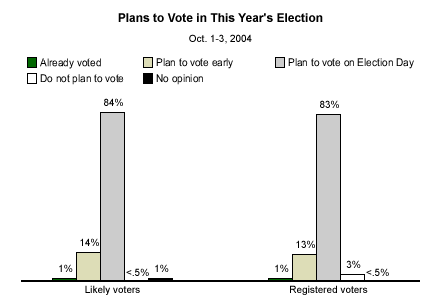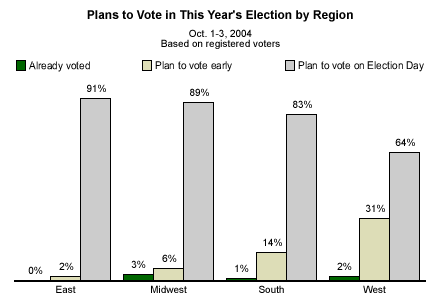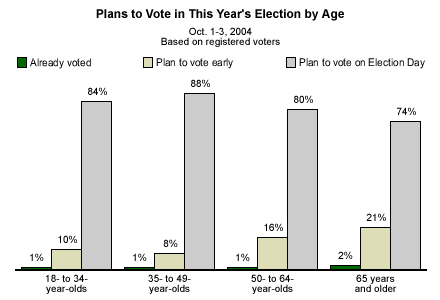For more than a century, voters have been able to vote early by absentee ballot under limited circumstances. Since the 1996 elections, however, there has been a growing trend of making it easier for voters to cast their ballots before Election Day. In this year's elections, there are about 30 states with no restrictions on voting early or voting via absentee ballots, including states west of the Missouri River. There are an additional 10 states where voters are allowed to cast their ballots earlier than Election Day with only minimal limitations. Voters in several of these states have already begun casting ballots, including Iowa, which allowed voting to start prior to the first presidential debate. Another state, Oregon, does not even operate polling centers to handle votes; Oregon voters are only able to vote through the mail.
A recent CNN/USA Today/║┌┴¤═° poll*, conducted Oct. 1-3, asked, "Which of the following applies to you -- you have already voted in this year's election, either by absentee ballot or early voting opportunities in your state, you plan to vote before Election Day, either by absentee ballot or early voting opportunities in your state, or you plan to vote on Election Day itself?"
The current results show 83% of registered voters say they plan to vote on Election Day, while 14% plan to vote before Election Day, including 1% of respondents who say they have already voted. Among the sample of the population deemed most likely to vote in this year's elections, the results show little difference, with 84% of likely voters planning to vote on Election Day, 15% planning to vote before Nov. 2.
║┌┴¤═° asked this question in late September and found similar results. Among registered voters, 79% planned to vote on Nov. 2, while 17% planned to vote early. Among likely voters in that poll, 81% said they would vote on Election Day, and 18% said they would vote early.

Westerners Most Likely to Vote Early
Residents in the western part of the country are much more likely than residents elsewhere to say they will vote before Election Day. This is not necessarily surprising because there are no restrictions on early or absentee voting in these states. According to the poll, 33% of registered voters living in the West plan to vote early, while 64% plan to vote on Election Day.
Voters are much less likely to vote early in the East (2%), the Midwest (9%), or in the South (15%).

Senior Citizens More Inclined to Vote Before Election Day
The poll also finds that older Americans are more inclined to say they will vote before Election Day than are younger Americans. In fact, 23% of registered voters aged 65 and older say they will vote early this year. These results compare with 11% of registered voters aged 18 to 34, 9% of those aged 35 to 49, and 17% of those aged 50 to 64 who say they plan to vote early. At least 8 in 10 registered voters who are younger than 65 plan to vote on Nov. 2.

Vote Intentions Among Other Groups
The data show only slight variations among registered voters in other demographic subgroups.
- Among Republicans, 15% plan to vote early, compared with 16% of
Democrats and 14% of independents.
- Fifteen percent of George W. Bush supporters say they will vote
before Election Day, while 14% of John Kerry voters plan to do
so.
- Roughly equal proportions of men (16%) and women (13%) plan to
vote early this year.
- Fourteen percent of voters earning $50,000 or more per year
plan to vote early. The same percentage of voters earning
less than $50,000 per year plan to vote early.
- Among those voters with a college degree, 11% plan to vote early, while 10% of voters with some college education and 17% of voters with only a high school diploma or less plan to vote early.
*Results are based on telephone interviews with 934 registered voters, aged 18 and older, conducted Oct. 1-3, 2004 For results based on this sample, one can say with 95% confidence that the margin of sampling error is ±4 percentage points.
Results based on likely voters are based on the subsample of 772 survey respondents deemed most likely to vote in the November 2004 general election, according to a series of questions measuring current voting intentions and past voting behavior. For results based on the total sample of likely voters, one can say with 95% confidence that the margin of sampling error is ±4 percentage points. The likely voter model assumes a turnout of 55% of national adults. The likely voter sample is weighted down to match this assumption.
In addition to sampling error, question wording and practical difficulties in conducting surveys can introduce error or bias into the findings of public opinion polls.